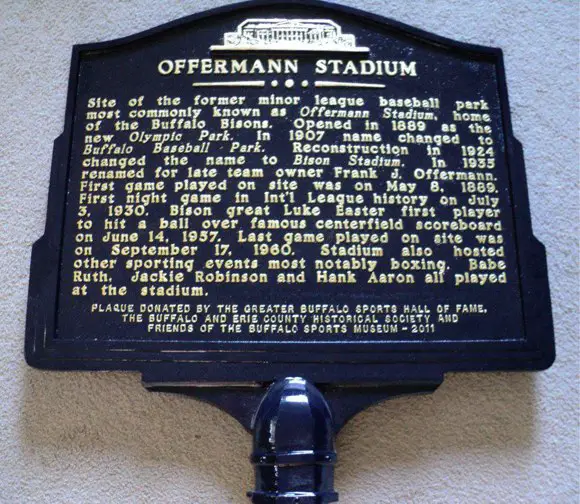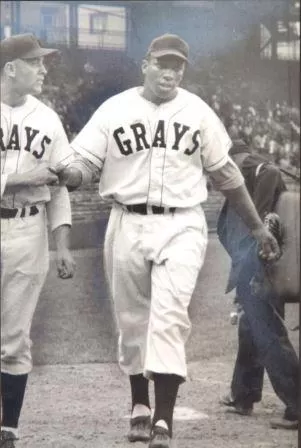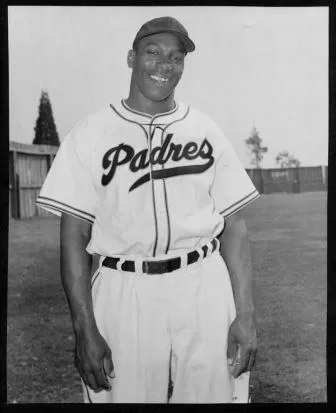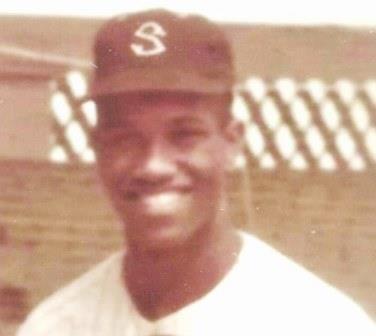Luscious “Luke” Easter had vision problems at the plate for the 1956 Buffalo Bisons. One evening Dr. Marvin H. Milch, a Buffalo ophthalmologist, was at a Bisons game with Harry Bisgeier, the team’s president and business manager. “I think I know what’s wrong with that big fellow [Easter],” said Milch. “He’s nearsighted. He doesn’t even see the ball until it’s halfway to the plate. Notice how late he swings. And when he is on the field, notice how slow he is getting the jump on the ball.” Easter was fitted for glasses when he went to Milch’s office, and said this when he returned to the ballpark: “I can see the scoreboard. I can see the ball real good.”
Easter was almost 42 when Sports Illustrated did a story on his 1957 season with Buffalo. They interviewed a 56-year old grandmother, Mrs. Irene Luedke, sitting at her home, 128 Woodlawn Avenue, when she heard this terrible crash, June 14, 1957. “I thought for sure someone had dropped an atom bomb on the roof. I quick ran out of the front door and there was this ball, rolling toward the front of the porch.” This was a home run ball off Luke Easter’s bat. Luedke’s home was directly behind the center-field scoreboard of the stadium, 412 feet from home plate. The scoreboard was sixty feet high; natural carry of the ball that hit Mrs. Luedke’s roof, was estimated at 550 feet, the longest homer ever hit in Buffalo, and the first over the scoreboard.

Luke Easter was born in Jonestown, Mississippi, a one-hour drive south of Memphis, Tennessee, on August 4, 1915, at 8:15 p.m., per Justin Murphy’s SABR bio of Easter, at https://sabr.org/bioproj/person/f29a4070. He was the fifth of ten children born to James and Maude Easter. The family moved to St. Louis in 1919. He attended the same high school as Quincy Trouppe, a talented catcher, but dropped out in the ninth grade. From 1937-1941, Easter played 1B for the St. Louis Titanium Giants, a talented company team. Sam Jethroe was one teammate when Jethroe’s car was involved in an accident, one where Easter suffered a broken ankle, an injury which limited his World War II military service to 13 months. Easter worked at a chemical plant through the end of the War, and was already 30 years old.
74 Barnstorming HR (1946), Negro Leagues (1947-48), Venezuela Winter League (1947-48)

His first pro team was the 1946 Cincinnati Crescents, owned by Abe Saperstein, famous for owning the Harlem Globetrotters. When the Crescents played a September-October 1946, 12-game series in Hawaii, Easter was listed as LF, clean-up hitter, wearing #1. Teammates included 2B Piper Davis, who also played for the Birmingham Black Barons, and 1B Reece “Goose Tatum, more famous as a basketball star with the Harlem Globetrotters. In 12 games versus Hawaii Winter League teams, Easter had a .480 AVG (24-for-50), seven HR, and 20 RBIs. Through the Hawaii series, he had 59 homers, and hit another 15 for the Crescents before their 1946 season ended. Easter had a .415 AVG with 74 HR, and 152 RBIs in 1946. The 74 HR are an all-time single-season record—MLB (Barry Bonds hit 73 for San Francisco Giants, 2001); U.S. minor-leagues (Joe Bauman hit 72, 1954 Roswell Rockets, class C Longhorn League).
The 1947 Washington Homestead Grays signed Easter. Per John Holway, he had a .338 AVG with 10 HR, tied with Lenny Pearson’s 10 HR for the Newark Eagles, and behind three other Eagles including Larry Doby (14), Monte Irvin (14), and Johnny Davis (13). One of Easter’s HR was the first one to leave the Polo Grounds, flying over the 484-foot sign in CF! Bob Thurman, Easter’s teammate, recalled it was a “line drive.” (Joe Adcock and Lou Brock became the only other players to do this, for Milwaukee and the Chicago Cubs, respectively.)
Easter traveled to Venezuela for winter ball. He was listed as 32 years old from Jonestown, Misisipi, the Spanish spelling. León Díaz was his manager with the 13-26 Venezuela Patriots, last-place team among four clubs. Easter was their best hitter with a .341 AVG, eight HR, and 18 RBIs, in 27 games. His .681 SLG was helped by five doubles and one triple. Dominican catcher Luis St. Claire (GuiGui Lucas) was a teammate; so was LHP Roy Partlow, plus pitchers’ Saul Rogovin and Max Surkont. The Sabios de Vargas (24-15) featured Don Newcombe (10-3) with Roy Campanella, .336 AVG, five HR, 21 RBIs, catching, and Luis Aparicio Sr., .322 AVG, at shortstop. Vidal López, .374 AVG for 17-24 Magallanes, was the league’s batting champ. The 25-14 Cervecería Criollos team had zero imports, fielding an all-native team.

Easter returned to the 1948 Homestead Grays and helped them win the last Negro Leagues World Series, in five games over the Birmingham Black Barons. Sammy Bankhead was the Grays player-manager (shortstop); Buck Leonard played 1B his final season; and, Bob Thurman (RF-P), Luis “Canena” Márquez (CF), and Easter (LF) formed a superb OF. Wilmer Fields (7-1) played 3B, when not pitching, and Thurman (6-4), R.T. Walker (7-3), and Tom Parker (7-4) were other contributors. The Grays had three of the league’s top five hitters: Buck Leonard #1, .395 AVG; Easter #3, .363 AVG; and, Thurman #5, .345 AVG. Fields won the fourth game of the 1948 World Series, played in New Orleans. He drove almost 24 hours from Washington, D.C. to New Orleans, before winning, 14-1! “I played in three Caribbean Series events,” said Fields, “but this was my only World Series. Luke Easter, Canena Márquez, and Bob Thurman were wonderful teammates. I played with Luke on that great 1948-49 Mayagüez ballclub…”
Los Indios de Mayagüez, 1948-49 Puerto Rico Winter League Champions

Jorge Colón Delgado’s 2019 book, Los Indios de Mayagüez, chronicles their epic 1948-49 season, with 51 wins and 29 losses; winning the league’s final series; and, representing Puerto Rico in the first Caribbean Series, February 20-25, 1949, in Havana, Cuba. Easter arrived in Puerto Rico, on October 14, 1948, two days before the season’s opener. By early December, he was tied for the league lead with Bob Thurman, with a .408 AVG, followed by catcher Dixie Howell of Aguadilla (.407), and Santurce’s Willard Brown’s .402. A month later, Easter’s AVG dipped to .353. Artie Wilson, Mayagüez’s player-manager, was at .393. Fields (.318), Johnny “Gaucho” Davis (.311), Alonzo Perry (.304), and Carlos Manuel Santiago (.300) were other Indios hitting .300 or higher. Easter’s bat got hot again, with a five-for-five game at Ponce, January 19, 1949, followed by four straight hits against Aguadilla the next day, before he grounded to second. (Easter’s nine straight hits tied a 10-year record of nine straight hits set by Rafael Echevarría of the 1938-39 Caguas Criollos.) Jorge Colón Delgado picked up the following nuggets from interviewees:
Cucú Cabrera opined Easter’s hitting was on a par with Josh Gibson. “Gibson’s homers went 500 feet, as did Easter’s. The RF fence in Mayagüez was 301 feet away, but quite high. Every blast Easter connected in that direction was at least 20 feet above the fence. Those HR he hit at Ponce went into the school, or between the school and dining area…” Nino Escalera, San Juan’s 1B, noted “there was no way to pitch Easter—he hit line drives to the opposite field, if he swung late.” Desiderio de León concurred: “You pitched him low and he would still drill it.” Statistician Monguí Carrasquillo claimed “Easter could hit it out even with the wind blowing in. He’s one of the strongest hitters I’ve ever seen since 1938.” When the regular season ended, Easter’s 100 hits in 249 AB gave him a league=best .402 AVG. Easter (81), Perry (76), Wilson (69), Márquez (65), and Carlos Bernier (64) were 1-2-3-4-5 in runs scored. Easter was first with 27 doubles and nine triples; third in HR (14), behind Willard Brown-Bob Thurman, who hit 18; tied for 2nd with Bernier with 15 SB; and, second in RBIs—80—to Fields’ 88. Easter was # 1 in SLG at .751. Island sportswriters determined Easter was the 1948-49 league’s Most Valuable Player (MVP).
Mayagüez (51-29) won four of six games versus Santurce (47-33), to punch their ticket to Havana for the Caribbean Series. They split a twin-bill at Sixto Escobar Stadium, February 13, 1949, before the Indios won two of three at home, Liga Paris, February 14-15-16. Fields outpitched Thurman in Game Three, 5-4, but Jim “Libertad” Lamarque blanked the Indios in Game Four, 3-0. Cefo Conde’s fine eight innings of relief pitching in Game Five gave “The Tribe” the edge going into Game Six at Escobar Stadium, February 18. Alonzo Perry went the route in a 6-2 win before a near-capacity crowd of 13,133 paid fans. A joyous caravan ensued from San Juan to Mayagüez, via Aguadilla, a “municipio” 18 miles north of Mayagüez on the Island’s West Coast.
Easter was given a cable from Bill Veeck, Cleveland Indians owner, as he boarded the plane to Havana. It was a 1949 contract to play for the Cleveland organization. Easter was happy, but always treated everyone nicely. Wito Conde, the 14-year old Mayagüez batboy, had received a baseball glove as a gift from Easter, earlier that season. Conde marveled at the cohesiveness of this team going into the Caribbean Series. Easter went 10-for-25 in Havana (.400), and .560 SLG, two doubles, one triple, seven RBIs, and one SB, but Mayagüez only won one of six contests, despite a series-leading .307 AVG. Their pitching was too weak, and unlike the host Almendares Scorpions—which had nine days of rest from winning Cuba’s title on February 11, 1949—Mayagüez scrambled to add several reinforcements for the series on February 19. They chose catcher Quincy Trouppe and IF Piper Davis, instead of pitchers such as Santurce’s John Ford Smith and Ponce’s Japhet “Red” Lynn, who both won 13 regular season games in Puerto Rico, the equivalent of 26 wins in a 162-game season. This proved to be a major mistake.
Cuban sportswriter Eladio Secades called Easter “the team’s best hitter, and most spectacular one we have seen since the days of Josh Gibson.” But Mayagüez lost to Spur Cola of Panamá, 13-9; to Almendares, 8-5, and to Cervecería Caracas, Venezuela, 5-3. Allegations emerged of team members partying in Havana. They outscored Panamá, 11-9, in Game Four, for their only win, February 23, behind a grand slam by Fields, before losing to Almendares, 11-4, and to Venezuela, 14-4. They had weak pitching, and no aces, unlike Agapito Mayor (3-0) and Conrado Marrero (1-0) with undefeated Almendares; José “Carrao” Bracho (2-0) and Mono Zuloaga, with 3-3 Venezuela; and Sam Jones, Panamá’s ace, who pitched 17 innings in two starts. Trouppe sported a .444 AVG (four-for-nine), with three RBIs, but the team already had three solid catchers—Luis “King Kong” Villodas, Chago Muratti, and Humberto “Pita” Martí—who were a combined eight-or-20 (.400 AVG), with five RBIs. Bottom line—Mayagüez scored 36 runs, but allowed 60 runs.
On a positive note, Easter re-connected with Sam Jethroe, Almendares CF, and Monte Irvin, who patrolled RF for the Scorpions. They each stole three bases in the six-game series; Irvin’s 11 RBIs led all players. Irvin (.389 AVG), Jethroe (.320 AVG), and Al Gionfriddo (series-best .533 AVG) were quite popular with Cuban fans. Easter met Chuck “Rifleman” Connors, the Almendares 1B and future actor; chatted with friend Sammy Bankhead, shortstop for 2-4 Spur Cola; and, practiced Spanish with Cervecería Caracas players, the only 1949 Caribbean Series team without Stateside reinforcements.
San Diego Padres (1949 and 1954), Cleveland Indians (1950-54), and Ottawa (1954)

Easter was the sensation of the 1949 Pacific Coast League, playing 80 games before undergoing surgery for a broken kneecap. He batted .363 (99-for-273) with 23 doubles, 25 HR, 92 RBIs, and a .722 SLG. Easter’s 45 walks to 21 strikeouts impressed Bill Veeck. His .460 OBP and 1.181 OPS were incredible, and he was on a pace for 58 HR and 200+ RBIs with the San Diego Padres. Easter’s right knee was first injured in a 1949 spring training collision with Larry Doby, and then damaged when an errant (some say, intentional) pitch hit that same knee. He underwent surgery by the end of June 1949. (Max West, Al Rosen, and Minnie Miñoso helped San Diego finish fourth (96-92) and make it to the league finals.)

Easter made his AL debut on August 11, 1949, as the 11th black player in MLB history; played hurt in 21 games, hitting zero HR with a .222 AVG. Coincidentally, Bob Feller won that August 11 game, 6-5, versus the Chicago White Sox. Larry Doby and Satchel Paige were the team’s other black players. Tris Speaker, per Easter’s SABR bio, stated: “the poor guy [Easter] came up under the worst possible conditions…[he] had nothing to do with the condition that made him the target of the boo birds.” Easter, a first-class individual who never made excuses, replied: “I hear them and I don’t hear them…if I hit, they’ll like me. If I don’t hit, I don’t deserve to be in the line-up.”
From 1950-to-1953, Easter did hit for Cleveland, starting with a May 6, 1950 HR off Allie Reynolds of the New York Yankees. Easter’s 1950 stats were a .280 AVG, 28 HR, and 107 RBIs. His 10 HBP led the AL. In 1951, he missed a month due to injuries, but still had a .270 AVG, 27 HR, and 103 RBIs, in 128 games. He turned 37 in 1952, his third full AL season, and cracked 31 HR, drove in 97, with a .263 AVG, including a demotion to the minors when he experienced vision problems. In 14 games with the Indianapolis Indians, he went 17-for-50, six HR, 12 RBIs, and 13 runs! His slash line was .340/.450/.740, with a 1.190 OPS. Al Rosen, his Cleveland teammate, was deeply impressed with Easter’s drive and determination. Between 1950-52, Easter averaged 29 HR and 102 RBIs in 132 AL games, despite injuries and deteriorating eyesight! In 1953, he was limited to 68 AL games, seven HR, 31 RBIs, and .303 AVG.
His six pinch-hitting appearances with Cleveland in 1954 were followed by 56 games, San Diego Padres, with a .278/.367/.525 slash line, .892 OPS, 13 HR, 42 RBIs; plus 66 games with Ottawa Athletics, International League: .348/.448/.587 slash line, and 1.035 OPS, 15 HR, and 48 RBIs. His AL career slash line was .274/.350/.481, with a .830 OPS, 93 HR, 340 RBIs, in 491 games, with 1,725 AB. Thirty-one HR every 575 MLB AB is good, considering Easter played for Cleveland from age 34-to-38; was hurt; and, was nearsighted from his mid-30s on, until fitted for glasses in Buffalo, during 1956. Part II, Luke Easter, picks up in the 1954-55 Mexico’s “Liga de la Costa del Pacífico (Pacific Coast Winter League) starting October 1, 1954.

